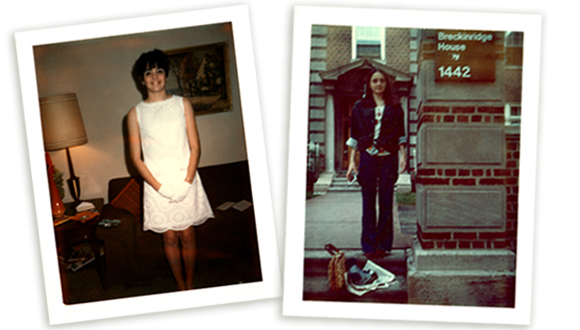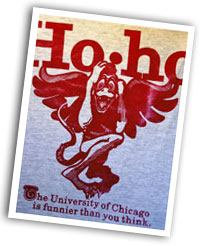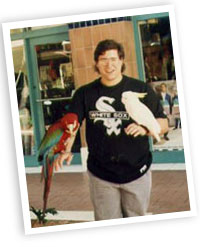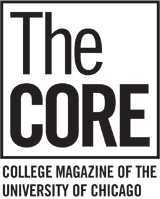
In Every Issue
Go Ask Alumni: Chicago Style
“Fashion is made to become unfashionable,” Coco Chanel observed. We asked alumni to share their memories of campus (anti)fashion.
Photo courtesy of Trish Cummings Charles
I came to Chicago in the fall of 1970. Having been considered a bit of a clotheshorse in my high school, I felt pretty comfortable about the clothes I had brought to college. Soon I learned how very wrong I was.
My electric rollers, fairly short bob, makeup mirror, and matching sweaters and skirts were not acceptable in this new environment. My roommate, who had hair down past her waist and wore bell-bottom jeans from an Army/Navy surplus store and fringed moccasins or hairy wolf boots on her feet, was the height of chic. We stared at each other in shock at our first meeting. I quickly threw all my stuff into my trunk and never took it out again. And of course I stopped shaving my legs and started letting my hair grow.
This was the time when women’s liberation was catching fire. Judy Chicago had a big exhibit at the Art Institute. I read Betty Friedan et al. and learned that wearing makeup and dresses and styling one’s hair were signs of an unliberated female, and I knew enough to know that I didn’t want to be seen as one of those.
I learned to dress myself only in bell-bottom jeans and cords, which I wore with cowboy shirts with pearl buttons or knit shirts with embroidery and mirrors. My mother crocheted a couple of vests, and I slipped those into my wardrobe, along with some leotards. I don’t think I wore a skirt the whole time I was there until graduation day. It took all four years at Chicago to get my hair to the length of my roommate’s, but I did it. I bought big “ethnic” earrings made of silver and various stones at the Art Institute and at street fairs, and I wore a brass cuff with a dragon made of mother-of-pearl. I’m sure if tattoos had been in vogue in those days, I would be covered with them right now.
When I went home in the summers and worked at a Walgreens-type store as a cashier and shelf stocker, the transformation occurred in reverse. I wore colored tights to cover my unshaved legs and my mother made me a handful of dresses. I went with her to pick out patterns and fabric, and I bought a pair of sandal platforms to wear with the dresses. I painted my nails and wore cologne and even some eye make-up. Partly I did this to satisfy my boss but I think I also enjoyed it. Clearly, I was missing my clotheshorse days.
My wardrobe changed again after graduation when I went into the workforce and saw that my college hairstyle and clothes were not well received. Needless to say, my wardrobe is bursting at the seams now.
One of several good things about being a student in the ’70s is our music and our clothes have come back into favor. My daughter hates it when I refer to her pants as “bell-bottoms,” insisting they are “flares.” She has let her hair grow and wears the same kind of dangling silver earrings that I always loved (and still do). Tie-dye seems to be a hit again, as well as those shirts with mirrors, although now the mirrors are plastic, not glass. I’m happily dressing again in long full skirts and sandals but keeping my hair above my chin.
—Trish Cummings Charles, AB’74
I arrived on campus in 1960 hoping for something different in the fashion department. In high school, those like me of lesser means envied the girls who came to school in stitched-down-pleated Pendleton skirts with cashmere sweaters in matching hues.
There was a style at the U of C—simple, not costly. It consisted of laid-back clothes in some variant of black and olive green. Well, maybe it was more of a theme than a style. I felt very “with it” with my (very heavy) olive-green book bag over my right shoulder (this shoulder is still overdeveloped today), and, copying those really cool girls from New York, black tights under rolled-up blue jeans or jeans tucked into high black boots.
I acquired a heavy, olive-green corduroy, fleece-lined winter coat, and I was in for the first time in my life. At a school where students actually spent Friday night in the library, it did not take much to look bookish, which was what we all were anyway.
—Sylvia Woodby Babus, AB’64
Two paper dresses. They endured several hand washes. They were cool for a sticky Chicago summer. They were cheap. They had nothing else to recommend them.
Blessedly, I have no photo of myself wearing one, but maybe some brave soul will send a photo of herself so dressed. I wore mine during a late 1960s summer, perhaps 1969.
—Louanna Furbee, PhD’74
 I am collaborating with my son Robert, Class of 2014, to reproduce the famed (at least when I was at Chicago) “Ho-ho: The University of Chicago Is Funnier Than You Think” T-shirt. The artwork was provided by my classmates Pia Lopez, AB’86, and James Read, AB’80, from their original T-shirts. I’m not sure if this is exactly what you had in mind, but if the T-shirt fits ...
I am collaborating with my son Robert, Class of 2014, to reproduce the famed (at least when I was at Chicago) “Ho-ho: The University of Chicago Is Funnier Than You Think” T-shirt. The artwork was provided by my classmates Pia Lopez, AB’86, and James Read, AB’80, from their original T-shirts. I’m not sure if this is exactly what you had in mind, but if the T-shirt fits ...
—John Huggins, AB’80
The overall fashion trend was blue jeans. They had much higher waists than what we see today. Girls’ jeans were tight, but not ready to split. None were completely blue, but they were not yet full of holes. I do believe that girls lightly bleached their jeans.
Most guys wore T-shirts with words or pullovers. I remember three major kinds of tops for girls: T-shirts with words, short-sleeved shirts with a few frills, sweaters. I do not remember seeing skirts or dresses, except at fancy events. Even then, nice pants were more common. Most guys had one nice outfit, but many never wore it.
—Ken Mellendorf, AB’86

This picture of me (left) from the fall of 1992 shows the confluence of ’80s mullet and ’90s hip-hop White Sox shirt. They don’t mix.
—Aaron Varhola, AB’92
